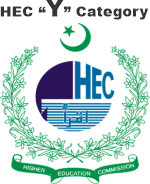EXAMINING THE IMPACT OF ISLAMIC MICROFINANCE ON MICRO-ENTREPRENEURSHIP: EVIDENCE FROM PAKISTAN'S FINANCIAL LANDSCAPE
Keywords:
Islamic Microfinance, Multinomial Logistic Regression, Micro-Entrepreneurship, Income Smoothing, Enterprise Resource Base.Abstract
The primary objective of the study is to explain the influence of Islamic microfinance in the progress of entrepreneurship development in Pakistan. Islamic microfinancing having unique characteristics of risk-sharing contracts and the distribution of wealth across the society through specific financial instruments has been gaining popularity in entrepreneurship and opening new avenues for future research. Self-administered questionnaires were used to collect the data from the users of Sharia-compliant products. The results of multinomial logistic regression reveal that Islamic microfinance has a significant impact on micro-entrepreneurship development. The policymakers, who promote the development of new ventures using Islamic microfinance, should ensure broadened access of the micro-entrepreneur to microfinance products. Moreover, Islamic microfinance institutions can contribute a lot to improving the living standards of entrepreneurs by becoming a link between government and people in policy implementation.
Downloads
References
Ahmad, S., Lensink, R., & Mueller, A. (2020). The double bottom line of microfinance: A global comparison between conventional and Islamic microfinance. World Development, 136, 105130.
Ahmad, S., Tahar, R. M., Muhammad-Sukki, F., Munir, A. B., & Rahim, R. A. (2016). Application of system dynamics approach in electricity sector modelling: A review. Renewable and Sustainable Energy Reviews, 56, 29-37.
Akhter, Jaffri. (2009). Islamic Micro-Finance and Poverty Alleviation: A Case of Pakistan. Proceedings 2nd CBRC, Lahore, Pakistan. M. Sadeq (1989), Factor Pricing and Income Distribution from An Islamic Perspective, Journal of Islamic Economics,
Alaro, A. A. M., & Alalubosa, A. H. (2019). The potential of Sharī’ah compliant microfinance in alleviating poverty in Nigeria. International Journal of Islamic and Middle Eastern Finance and Management.
Berguiga, I., Said, Y. B., & Adair, P. (2020). Islamic and Conventional Micro-Financing in the MENA Region: A Performance Analysis. In Handbook of Research on Theory and Practice of Global Islamic Finance (pp. 216-239). IGI Global.
Crépon, Bruno, Florencia Devoto, Esther Duflo, and William Parienté. "Estimating the impact of microcredit on those who take it up: Evidence from a randomized experiment in Morocco." American Economic Journal: Applied Economics 7, no. 1 (2015): 123-50.
El-Gamal, M. A., (2006). Islamic Finance: Law, Economics and Practice. Cambridge: Cambridge University Press
El-Komi, M., & Croson, R. (2013). Experiments in Islamic microfinance. Journal of Economic Behavior & Organization, 95, 252-269.
Field, A. (2009). Logistic regression. Discovering statistics using SPSS, 264- 315.
Jalil, M. F., Ali, A., & Ahmed, Z. (2022). Microfinance services and MSE growth in Pakistan: The mediating perspective of social and psychological capital.
Kenny, B., & Rossiter, I. (2018). Transitioning from unemployment to self-employment for over 50s. International Journal of Entrepreneurial Behavior & Research.
Khan, M. F. Z. (2014). The Social and Financial Performance of Conventional and Islamic Microfinance Institutions in Pakistan. Al-Idah, 28(1), 17-34.
Komi and Croson(2011) ‘Efficiency of Islamic Finance Contracts: Microfinance Experiments’, 8th International Conference on Islamic Economics and Finance.
Mahmood, R., & Rosli, M. M. (2013). Microcredit position in micro and small enterprise performance: the Malaysian case. Management research review.
Maldonado, J. H., González-Vega, C., & Romero, V. (2005). The influence of microfinance on the education decisions of rural households: Evidence from Bolivia. Universidad de los Andes
Mansori, S., Safari, M., & Ismail, Z. M. M. (2020). An analysis of the religious, social factors and income’s influence on the decision making in Islamic microfinance schemes. Journal of Islamic Accounting and Business Research.
Masyita, D., Ahmed, H. (2013). Why is the Growth of Islamic Microfinance Lower than its Conventional Counterparts in Indonesia? Islamic Economic Studies, 21(1), 35-62.
Meressa, H. A. (2020). Growth of micro and small scale enterprises and its driving factors: empirical evidence from entrepreneurs in emerging region of Ethiopia. Journal of Innovation and Entrepreneurship, 9(1), 1-22.
Moisseron, J. Y., Moschetto, B. L., & Teulon, F. (2015). Islamic finance: a review of the literature. International Business & Economics Research Journal (IBER), 14(5), 745-762.
Mondal, W. I. (2015), “Microcredit and Micro entrepreneurship: An Extension of Schupeter’s Five-Factor Model”, University of Redlands,.1-7
Naveed Aslam, M. (2014). Role of Islamic microfinance in poverty alleviation in Pakistan: An empirical approach. International Journal of Academic Research in Accounting, Finance and Management Sciences, 4(4).
Nelson, C., Garber, C., MkNelly, B., Lippold, K., Edgcomb, E., Horn, N., & Beard, B. (2000). Learning from Clients. Assessment Tools for Microfinance.
Nelson, C., MkNelly, B., Edgcomb, E., Gaile, G., Garber, C., Horn, N., & Lippold, K. (2000). Learning from clients: Assessment Tools for Microfinance Practitioners–Draft Manual. January. AIMS Project and SEEP. Washington, DC: Management Systems International.
Newman, A., Schwarz, S., & Ahlstrom, D. (2017). Microfinance and entrepreneurship: An introduction. International Small Business Journal, 35(7), 787-792.
Obaidullah, M., (2008). Introduction to Islamic Microfinance. New Delhi: International Institute of Islamic Business ad Finance.
Riwajanti, N. I. (2013). Islamic Microfinance as an Alternative for Poverty Alleviation: A Survey. Afro Eurasian Studies, 2(1-2), 255-271.
Santoso, D. B., Gan, C., Revindo, M. D., & Massie, N. W. G. (2020). The impact of microfinance on Indonesian rural households' welfare. Agricultural Finance Review.
Shahriar, A. Z. M., Schwarz, S., & Newman, A. (2016). Profit orientation of microfinance institutions and provision of financial capital to business start-ups. International Small Business Journal, 34(4), 532-552.
Suzuki, Y., Pramono, S., & Rufidah, R. (2016). Islamic Microfinance and Poverty Alleviation Program: Preliminary Research Findings from Indonesia. Share: Jurnal Ekonomi dan Keuangan Islam, 5(1).
Terano, R., Mohamed, Z., & Jusri, J. H. H. (2015). Effectiveness of microcredit program and determinants of income among small business entrepreneurs in Malaysia. Journal of Global Entrepreneurship Research, 5(1), 22.
Weill, L. (2019). Islamic microfinance. In A Research Agenda for Financial Inclusion and Microfinance. Edward Elgar Publishing.
Akhmadjonov, O., Valijonov, M., Usmonov, I., & Qurbonov, A. (2022). Islamic banking and finance. Science and Education, 3(1), 1092-1098.

Downloads
Published
Issue
Section
License
Copyright (c) 2024 PAKISTAN ISLAMICUS (An International Journal of Islamic & Social Sciences)

This work is licensed under a Creative Commons Attribution 4.0 International License.
This work is licensed under a Creative Commons Attribution 4.0 International License.
































